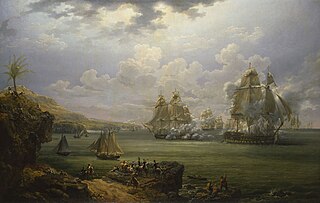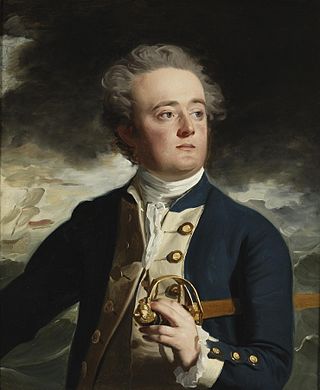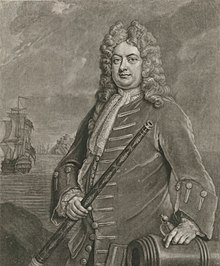HMS Vanguard was a 74-gun third-rate ship of the line of the Royal Navy, launched on 6 March 1787 at Deptford. She was the sixth vessel to bear the name.

René Trouin, Sieur du Gué, also known as René Duguay-Trouin, was a French naval officer, nobleman, slave trader, and privateer best known for his career during the War of the Spanish Succession in the early 18th century. He had a brilliant privateering and naval career, eventually becoming Lieutenant-General of the Naval Armies of the King in 1728, as well as a Commander in the Order of Saint-Louis. Ten ships of the French Navy have since been named in his honour.

The naval Battle of the Lizard took place on 21 October 1707 during the War of the Spanish Succession near Lizard Point, Cornwall between two French squadrons under René Duguay-Trouin and Claude de Forbin and an English convoy protected by a squadron under Commodore Richard Edwards.

HMS Implacable was a 74-gun third-rate ship of the line of the Royal Navy. She was originally the French Navy's Téméraire-class ship of the line Duguay-Trouin, launched in 1800.

HMS Latona was a 36-gun, fifth-rate frigate of the Royal Navy that served during the American Revolutionary War, the French Revolutionary Wars, and the Napoleonic Wars. Shortly after her launch in 1781, she participated in the Battle of Dogger Bank against a Dutch squadron in the North Sea. In September 1782, Latona took part in the relief of Gibraltar and was the first ship in the convoy to pass through the Straits, when Richard Howe sent her ahead, to spy on the condition of the Franco-Spanish fleet in Algeciras Bay.

Admiral of the White Sir John Balchen, sometimes written as Balchin, was an officer of the British Royal Navy with a long and distinguished career during the late 17th and early 18th centuries. In the course of his service at sea, Balchen saw action in numerous battles against the French and Spanish navies across 60 years and three separate wars. He was twice captured by the French in action, both times being exonerated and commended for the defence of his ships against overwhelming odds.

Jean-Baptiste Philibert Willaumez was a French naval officer and nobleman who served during the French Revolutionary Wars and Napoleonic Wars. Willaumez joined the French Navy at the age of 14, and proved to be a competent sailor. Having risen to the rank of pilot, he started studying navigation, attracting the attention of his superiors up to Louis XVI himself. Willaumez eventually became an officer and served under Antoine Bruni d'Entrecasteaux in his expedition to rescue Jean-François de Galaup, comte de Lapérouse and explore the Indian Ocean and Oceania.
Barrington Dacres was an officer of the Royal Navy, who saw service during the French Revolutionary and Napoleonic Wars. He eventually rose to the rank of Post-Captain. He did not see action in many significant engagements, and is chiefly remembered for the accidental loss of his ship to the French, and for the unsuccessful chase of two French ships in the English Channel. He did command a number of ships of the line under several of the leading naval commanders of his time. His early death, however, prevented him from achieving the same seniority and degree of fame as his relatives did.
Admiral Sir Lawrence William Halsted GCB was an officer of the Royal Navy who served during the American War of Independence and the French Revolutionary and Napoleonic Wars.
Samuel Granston Goodall was an officer of the Royal Navy who saw service during the Seven Years' War, the American War of Independence and the French Revolutionary Wars in a career that spanned 50 years, rising to the rank of Admiral of the White.

The blockade of Saint-Domingue was a naval campaign fought during the first months of the Napoleonic Wars in which a series of British Royal Navy squadrons blockaded the French-held ports of Cap-Français and Môle-Saint-Nicolas on the northern coast of the French colony of Saint-Domingue, soon to become Haiti, after the conclusion of the Haitian Revolution on 1 January 1804. In the summer of 1803, when war broke out between the United Kingdom and the French Consulate, Saint-Domingue had been almost completely overrun by Haitian Armée Indigène troops led by Jean-Jacques Dessalines. In the north of the country, the French forces were isolated in the two large ports of Cap-Français and Môle-Saint-Nicolas and a few smaller settlements, all supplied by a French naval force based primarily at Cap-Français.

John Loring was an officer in the Royal Navy who served during the American War of Independence and the French Revolutionary and Napoleonic Wars.

Vice-Admiral Charles Stewart was an officer of the Royal Navy who saw service during the Nine Years' War, and the Wars of the Spanish Succession, Quadruple Alliance and Austrian Succession. He embarked on a political career, and was a Member of Parliament for the Parliaments of Ireland and Great Britain.
HMS Roebuck was a 44-gun, fifth-rate sailing warship of the Royal Navy which carried a main battery of twenty 18-pounder (8.2 kg) long guns. Launched on 21 December 1743, she first served in the English Channel during the War of the Austrian Succession, which Britain entered the following March.

Richery's expedition was a French naval operation during 1795 and 1796 as part of the French Revolutionary Wars. The operation was led by Commodore Joseph de Richery and comprised two separate cruises; the first was an operation off Cádiz in Southern Spain in which Richery attacked and defeated a large British merchant convoy with a weak escort, taking many prizes. Forced to anchor at Cádiz, the French squadron was subsequently blockaded in the port for almost a year. Richery was enabled to escape in August 1796 by a Spanish fleet, and went on to attack British fisheries off Newfoundland and Labrador before returning to France having inflicted severe damage to British Atlantic trade.
Vice-Admiral Sir Charles Hardy, also known as Sir Charles Hardy the Elder, was a Royal Navy officer of the eighteenth century. Hardy entered the Royal Navy in 1695, joining his cousin Captain Thomas Hardy's ship HMS Pendennis. Promoted to lieutenant in 1701, he served in several ships of the line before being promoted to commander in 1705. Hardy commanded sloops in the English Channel, Mediterranean and North Seas, before taking command of HMS Dunwich in 1709, in which he was promoted to post captain. Hardy subsequently served for a year at Jamaica before commanding two ships during the Great Northern War between 1718 and 1720. Having changed commands several times, in 1727 he fought at the thirteenth siege of Gibraltar in HMS Kent.
Rear-Admiral Polycarpus Taylor was a Royal Navy officer of the eighteenth century, most notable for his service commanding ships in the West Indies during the War of the Austrian Succession. Having joined the Royal Navy some time before 1733, Taylor then served at the Battle of Cartagena de Indias and Invasion of Cuba before being promoted to commander in 1742. After commanding several vessels and being promoted to post-captain, in August 1744 Taylor took command of HMS Fowey; serving in the English Channel he ran ashore and destroyed the French privateer Griffon in 1745.
Captain Sir Andrew Leake was a Royal Navy officer of the late seventeenth and early eighteenth centuries, who distinguished himself at the Battle of Vigo Bay, during the War of the Spanish Succession. From Lowestoft, Leake joined the navy in 1688 under the patronage of John Ashby. Promoted to commander, Leake fought under Ashby as a supernumerary at the Action at La Hogue in 1692. His services at La Hogue brought him promotion to captain, and a series of commands that culminated in 1702 with Leake joining HMS Torbay. At Vigo Bay later that year Torbay broke the boom protecting a Franco-Spanish treasure fleet, resulting in the capture or destruction of the entire fleet. Leake was knighted for this, and went on to command HMS Grafton at the Capture of Gibraltar in 1704. He was mortally wounded at the Battle of Málaga later the same year.
Vice-Admiral Philip Wodehouse was a Royal Navy officer. A son of John Wodehouse, 1st Baron Wodehouse, he joined the navy some time before 1794. In 1796 he was promoted to commander and then captain, commanding sloops and frigates in the Mediterranean Fleet. Wodehouse cycled through a series of frigate commands towards the end of the French Revolutionary Wars, including HMS Mignonne which he had to burn as useless in 1797. In 1803, while commanding HMS Resistance, his ship was wrecked off Cape St Vincent. Wodehouse subsequently commanded several ships of the line, including HMS Cumberland in the Mediterranean where in 1809 he fought at the Battle of Maguelone. Wodehouse was appointed Resident Commissioner, Halifax, in 1811 and served there until the dockyard was closed in 1819. He was promoted to rear-admiral later in the year. Wodehouse saw no further active service, but was promoted to vice-admiral in 1830.
Rear-Admiral Robert Hughes was a Royal Navy officer. Having joined the navy in the late seventeenth century, he served as a lieutenant in several ships of the line during the Nine Years' War before being promoted to captain in 1697. His first command was HMS Flamborough in which he captured several privateers off Dunkirk at the start of the War of the Spanish Succession, before taking command of HMS Winchester.














